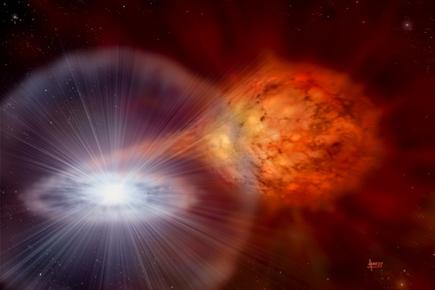The expansion of thermonuclear fireball from a nova that erupted last year in the constellation Delphinus was more complicated than the simple models used previously would have predicted, suggest astronomers including an Indian

The expansion of thermonuclear fireball from a nova that erupted last year in the constellation Delphinus was more complicated than the simple models used previously would have predicted, suggest astronomers including an Indian
Washington: The expansion of thermonuclear fireball from a nova that erupted last year in the constellation Delphinus was more complicated than the simple models used previously would have predicted, suggest astronomers including an Indian.
ADVERTISEMENT
The observations made by the international team produced the first images of a nova during the early fireball stage and revealed how the structure of the ejected material evolves as the gas expands and cools.

Artist's conception of a nova with a stream of matter being drawn from the donor star (right) to the compact white dwarf (left). David A. Hardy / astroart.org
The results of these observations, carried out by a collaboration of 37 researchers from 17 institutions and led by Georgia State astronomer Gail Schaefer, are published in the current issue of Nature, according to a media release from Georgia State University.
A nova occurs following the buildup of a thin layer of hydrogen on the surface of a white dwarf -- a highly evolved star with the diameter of the Earth and the mass of the Sun.
The hydrogen is provided by a close companion, which is a normal star, in a binary star system, wherein the two stars orbit about their centre of mass.
On Aug 14, 2013, the Japanese amateur astronomer Koichi Itagaki discovered a "new" star that was promptly named Nova Delphinus 2013.
Within 15 hours of the discovery and within 24 hours of the actual explosion, astronomers at Georgia State University's Center for High Angular Resolution Astronomy (CHARA) pointed the telescopes of the CHARA Array, toward it.
Located on the grounds of historic Mount Wilson Observatory in the San Gabriel Mountains of Southern California, CHARA measured the size of the nova on a total 27 nights over the course of two months. The first measurement represents the earliest size yet obtained for a nova event.
The CHARA facility has the power to resolve the size of a US nickel on the top of the Eiffel tower in Paris from the distance of Los Angeles, California.
Collaborator Professor Dipankar Banerjee at the Indian Physical Research Laboratory commented that, "Since novae can dim rapidly after their outburst, having sufficient brightness and resolution at the critical times is very challenging. CHARA is one of the few instruments in the world that can do this."
CHARA's measurement of the angular expansion rate of the nova, combined with measurements of the expansion velocity from independent spectroscopic observations, allowed the researchers to determine the distance to the star.
Nova Del 2013 was found to be 14,800 light-years from the Sun. This means that, while the explosion was witnessed on Earth last August, it actually took place nearly 15,000 years ago.
Knowing the nova's distance along with its angular size allows the determination of the physical size of the fireball at the different times of observation.
During the first CHARA observation on Aug 15, 2013, the size of the fireball was roughly the size of Earth's orbit.
Two days later, it was already the size of Mars' orbit, and by day twelve, the fireball surface would extend out to the orbit of Jupiter.
When last measured 43 days after the detonation, it had expanded nearly twenty-fold from the first measurement to nearly the size of Neptune's orbit, the outermost planet in earth's solar system.
This incredible expansion rate of more than 600 kilometres-per-second (over 1.3 million miles-per-hour) was fuelled by the violence of the thermonuclear explosion of the hydrogen on the white dwarf's surface.
The CHARA observations also showed that the outer layers of the fireball became more diffuse and transparent as it expanded.
 Subscribe today by clicking the link and stay updated with the latest news!" Click here!
Subscribe today by clicking the link and stay updated with the latest news!" Click here!






